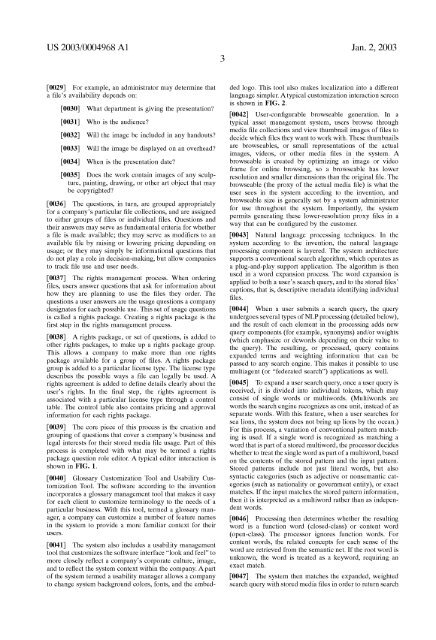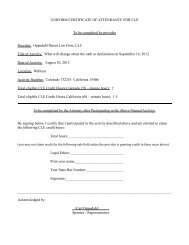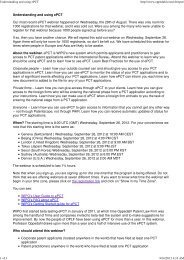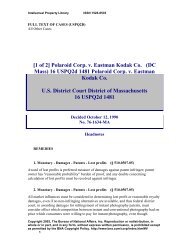Patent Application Publication (10) pub. NO.: US 2003/0004968 A1
Patent Application Publication (10) pub. NO.: US 2003/0004968 A1
Patent Application Publication (10) pub. NO.: US 2003/0004968 A1
You also want an ePaper? Increase the reach of your titles
YUMPU automatically turns print PDFs into web optimized ePapers that Google loves.
Jan. 2,<strong>2003</strong><br />
[0029] For example, an administrator may determine that<br />
a file's availability depends on:<br />
[0030] What department is giving the presentation?<br />
[0031] Who is the audience?<br />
[0032] Will the image be included in any handouts?<br />
[0033] Will the image be displayed on an overhead?<br />
[0034] When is the presentation date?<br />
[0035] Does the work contain images of any sculpture,<br />
painting, drawing, or other art object that may<br />
be copyrighted?<br />
[0036] The questions, in turn, are grouped appropriately<br />
for a company's particular file collections, and are assigned<br />
to either groups of files or individual files. Questions and<br />
their answers may serve as fundamental criteria for whether<br />
a file is made available; they may serve as modifiers to an<br />
available file by raising or lowering pricing depending on<br />
usage; or they may simply be informational questions that<br />
do not play a role in decision-making, but allow companies<br />
to track file use and user needs.<br />
[0037] The rights management process. When ordering<br />
files, users answer questions that ask for information about<br />
how they are planning to use the files they order. The<br />
questions a user answers are the usage questions a company<br />
designates for each possible use. This set of usage questions<br />
is called a rights package. Creating a rights package is the<br />
first step in the rights management process.<br />
[0038] A rights package, or set of questions, is added to<br />
other rights packages, to make up a rights package group.<br />
This allows a company to make more than one rights<br />
package available for a group of files. A rights package<br />
group is added to a particular license type. The license type<br />
describes the possible ways a file can legally be used. A<br />
rights agreement is added to define details clearly about the<br />
user's rights. In the final step, the rights agreement is<br />
associated with a particular license type through a control<br />
table. The control table also contains pricing and approval<br />
information for each rights package.<br />
[0039] The core piece of this process is the creation and<br />
grouping of questions that cover a company's business and<br />
legal interests for their stored media file usage. Part of this<br />
process is completed with what may be termed a rights<br />
package question role editor. A typical editor interaction is<br />
shown in FIG. 1.<br />
[0040] Glossary Customization Tool and Usability Customization<br />
Tool. The software according to the invention<br />
incorporates a glossary management tool that makes it easy<br />
for each client to customize terminology to the needs of a<br />
particular business. With this tool, termed a glossary manager,<br />
a company can customize a number of feature names<br />
in the system to provide a more familiar context for their<br />
users.<br />
[0041] The system also includes a usability management<br />
tool that customizes the software interface "look and feel" to<br />
more closely reflect a company's corporate culture, image,<br />
and to reflect the system context within the company. Apart<br />
of the system termed a usability manager allows a company<br />
to change system background colors, fonts, and the embed-<br />
ded logo. This tool also makes localization into a different<br />
language simpler. A typical customization interaction screen<br />
is shown in FIG. 2.<br />
[0042] User-configurable browseable generation. In a<br />
typical asset management system, users browse through<br />
media file collections and view thumbnail images of files to<br />
decide which files they want to work with. These thumbnails<br />
are browseables, or small representations of the actual<br />
images, videos, or other media files in the system. A<br />
browseable is created by optimizing an image or video<br />
frame for online browsing, so a browseable has lower<br />
resolution and smaller dimensions than the original file. The<br />
browseable (the proxy of the actual media file) is what the<br />
user sees in the system according to the invention, and<br />
browseable size is generally set by a system administrator<br />
for use throughout the system. Importantly, the system<br />
permits generating these lower-resolution proxy files in a<br />
way that can be configured by the customer.<br />
[0043] Natural language processing techniques. In the<br />
system according to the invention, the natural language<br />
processing component is layered. The system architecture<br />
supports a conventional search algorithm, which operates as<br />
a plug-and-play support application. The algorithm is then<br />
used in a word expansion process. The word expansion is<br />
applied to both a user's search query, and to the stored files'<br />
captions, that is, descriptive metadata identifying individual<br />
files.<br />
[0044] When a user submits a search query, the query<br />
undergoes several types of NLP processing (detailed below),<br />
and the result of each element in the processing adds new<br />
query components (for example, synodyms) and/or weights<br />
(which emphasize or dewords depending on their value to<br />
the query). The resulting, or processed, query contains<br />
expanded terms and weighting information that can be<br />
passed to any search engine. This makes it possible to use<br />
multiagent (or "federated search") applications as well.<br />
[0045] To expand a user search query, once a user query is<br />
received, it is divided into individual tokens, which may<br />
consist of single words or multiwords. (Multiwords are<br />
words the search engine recognizes as one unit, instead of as<br />
separate words. With this feature, when a user searches for<br />
sea lions, the system does not bring up lions by the ocean.)<br />
For this process, a variation of conventional pattern matching<br />
is used. If a single word is recognized as matching a<br />
word that is part of a stored multiword, the processor decides<br />
whether to treat the single word as part of a multiword, based<br />
on the contents of the stored pattern and the input pattern.<br />
Stored patterns include not just literal words, but also<br />
syntactic categories (such as adjective or nonsemantic categories<br />
(such as nationality or government entity), or exact<br />
matches. If the input matches the stored pattern information,<br />
then it is interpreted as a multiword rather than as independent<br />
words.<br />
[0046] Processing then determines whether the resulting<br />
word is a function word (closed-class) or content word<br />
(open-class). The processor ignores function words. For<br />
content words, the related concepts for each sense of the<br />
word are retrieved from the semantic net. If the root word is<br />
unknown, the word is treated as a keyword, requiring an<br />
exact match.<br />
[0047] The system then matches the expanded, weighted<br />
search query with stored media files in order to return search





